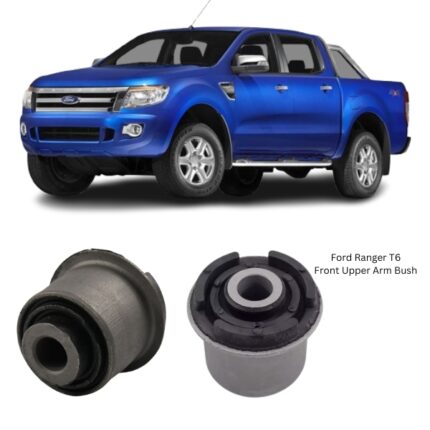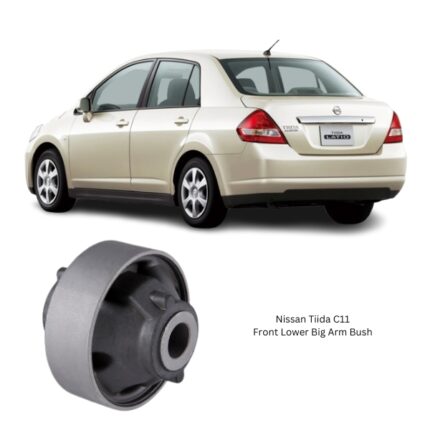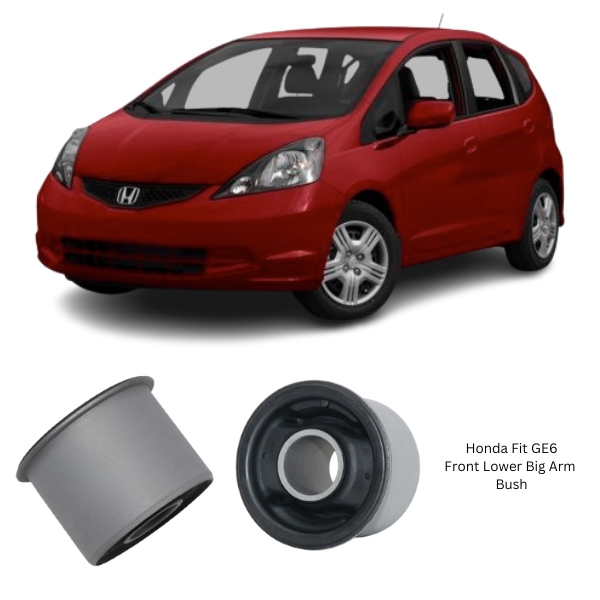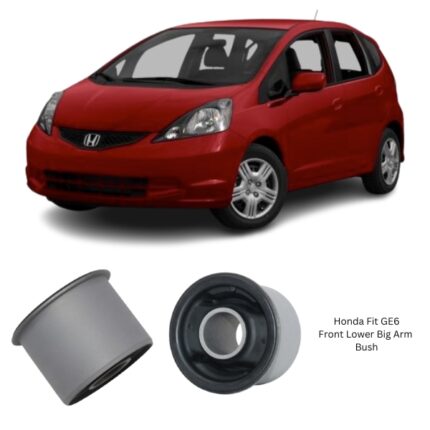Get Honda Fit GE6 Front Lower Big Arm Bush 52385-TG0-H15 in Kenya
The Front Lower Big Arm Bush is a core component of a vehicle’s front suspension system. Though often overlooked due to its relatively small size, this bushing plays a vital role in absorbing road shocks, maintaining suspension geometry, and enabling safe, stable handling. Mounted within the lower control arm assembly—commonly referred to as the “big arm” because of its robust construction—the bush ensures that suspension movement is well-controlled and consistent.
By providing a flexible joint between the lower arm and the vehicle chassis or subframe, the front lower big arm bush allows necessary suspension articulation while minimizing unwanted noise, vibration, and harshness. Its proper function is critical to ride quality, steering precision, and the longevity of adjacent suspension components.
Function and Role in the Suspension System
The front suspension of a vehicle is tasked with maintaining wheel contact with the road surface, absorbing shocks, and enabling steering control. The Front Lower Big Arm Bush is mounted at one or both ends of the lower control arm and acts as a pivot point that allows the arm to move up and down during suspension travel.
Primary Functions:
-
Dampening Vibrations
Absorbs and dissipates road noise and vibrations before they reach the vehicle cabin. -
Controlling Movement
Allows for vertical motion of the control arm while restricting unwanted horizontal or lateral flex. -
Maintaining Alignment
Helps keep the suspension geometry intact—especially toe and camber—so the wheels track properly under braking, cornering, and acceleration. -
Load Distribution
Spreads out the stresses and forces transferred between the control arm and vehicle body, reducing wear on mounting points. -
Improving Ride Comfort
Enhances overall ride smoothness by isolating shocks and jolts caused by road imperfections.
Without a properly functioning bush, suspension movement becomes uncontrolled, resulting in poor alignment, uneven tire wear, and compromised driving safety.
Design and Material Composition
The Front Lower Big Arm Bush is designed to withstand extreme operating conditions, including compression, shear forces, temperature fluctuations, and chemical exposure. It consists of several key parts:
Key Components:
-
Outer Metal Sleeve
A rigid cylindrical housing that is press-fitted into the control arm bracket. -
Inner Metal Sleeve
Positioned centrally to receive the suspension bolt, it remains stationary relative to the chassis. -
Elastomeric Core (Rubber or Polyurethane)
This is the main damping material between the two sleeves. It compresses and flexes to accommodate movement while returning to its original shape after each cycle. -
Bonded Construction
The rubber or polymer core is often chemically bonded to both inner and outer sleeves, preventing rotation or slippage and allowing precise force transfer.
Material Types:
-
Natural Rubber
Offers a balance of flexibility, vibration absorption, and comfort. Widely used in OEM applications. -
Polyurethane (PU)
Provides greater stiffness, durability, and resistance to deformation, making it ideal for performance or heavy-duty applications.
The bush is engineered to allow limited but controlled deflection. Some versions include voids, slots, or directional designs to fine-tune stiffness in specific axes—such as lateral vs. vertical movement.
Performance Characteristics
A properly manufactured and installed Front Lower Big Arm Bush significantly improves the performance of a vehicle’s suspension system. Its effectiveness can be assessed by the following characteristics:
-
Durability and Fatigue Resistance
Capable of enduring repeated loading cycles without cracking, splitting, or tearing. -
Temperature Tolerance
Maintains integrity in extreme heat or cold without becoming brittle or overly soft. -
Chemical Resistance
Designed to withstand contact with oils, road salt, water, brake fluid, and other automotive chemicals. -
Low NVH Transmission
Reduces Noise, Vibration, and Harshness (NVH) levels, leading to a smoother and quieter driving experience. -
Alignment Stability
Ensures consistent suspension geometry, minimizing steering drift and maintaining straight-line stability.
In short, this bushing allows for controlled flexibility while protecting more rigid suspension components from stress and damage.
Signs of Wear or Failure
Over time, the Front Lower Big Arm Bush may degrade due to normal wear and tear, aggressive driving, off-road use, or harsh weather exposure.
Common Symptoms of a Worn or Failing Bush:
-
Clunking or Knocking Sounds
Often heard from the front suspension when going over bumps, braking, or during sudden acceleration. -
Steering Wander or Instability
The vehicle may drift or pull to one side, especially under load or braking. -
Uneven Tire Wear
A misaligned suspension can lead to feathering or edge wear on front tires. -
Excessive Vibration
More vibration may be felt through the steering wheel or chassis due to reduced damping capability. -
Visible Damage
Cracks, splits, or complete separation of the rubber from its metal casing can be identified during inspection. -
Increased Braking Distance
Unstable suspension geometry may affect brake performance, especially under sudden stops.
Addressing these issues early helps prevent damage to ball joints, shocks, and control arms.
Replacement and Installation
Replacing a Front Lower Big Arm Bush requires specific tools and mechanical knowledge. It is typically pressed into the control arm and must be removed and installed with precision.
General Steps:
-
Lift and Secure the Vehicle
Raise the front of the vehicle and remove the wheel to gain access. -
Remove the Control Arm
Unbolt the arm from the subframe and the knuckle. You may need to detach the sway bar or ball joint. -
Press Out the Old Bush
Using a hydraulic press or removal tool, carefully extract the worn bush. -
Install the New Bush
Align and press the new bush into place, ensuring it sits flush and is correctly oriented. -
Reinstall Control Arm
Bolt the arm back in place and torque all fasteners to manufacturer specifications. -
Perform Wheel Alignment
Always conduct a suspension alignment after replacing control arm bushes to restore correct geometry.
Inspection and Maintenance
Routine inspection of the Front Lower Big Arm Bush should be part of any comprehensive suspension check, particularly:
-
During routine servicing
-
After hitting potholes or curbs
-
When replacing shocks or springs
-
If tire wear or steering issues are observed
Though not a maintenance item per se, early detection of wear prevents further component damage.
Benefits of Timely Replacement
-
Restored Suspension Integrity
Keeps the vehicle stable, especially under dynamic conditions. -
Enhanced Steering Feedback
Sharpens responsiveness and reduces play in the steering system. -
Improved Comfort
Dampens harshness from road irregularities for a smoother ride. -
Prolonged Tire Life
Reduces uneven wear by maintaining suspension alignment. -
Increased Safety
Ensures predictable vehicle behavior during emergency maneuvers or hard braking.
Follow us on Facebook for more parts.





Reviews
Clear filtersThere are no reviews yet.